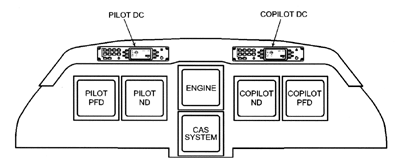It's hard to see from the angle that your example photos were taken from, but the main reason is that they want the primary flight instruments (which are on the PFD, or Primary Flight Display) directly in front of the pilot, no matter which seat they are in.
The PFD gives the most critical information which is used to actualy control and fly the aircraft, so is designed to be in the pilot's direct line of sight.
Less critical information is put on the MFD (Multi Function Display). Since the pilots sit close to each side of the cockpit, this usually means that there isn't room to place the MFD on the outside of the PFD. Even if there was room, the extra display is used partially for redundancy, so they don't want to put it further away from the other pilot.
Since the PFD is directly in front of each pilot, it doesn't take any effort to switch between seats because of that aspect.
This photo (it's night, so a little dark but I think that you can see what I'm referring to) was taken from my head level while sitting in the right seat, which should make it pretty clear:
 own photo
own photo



